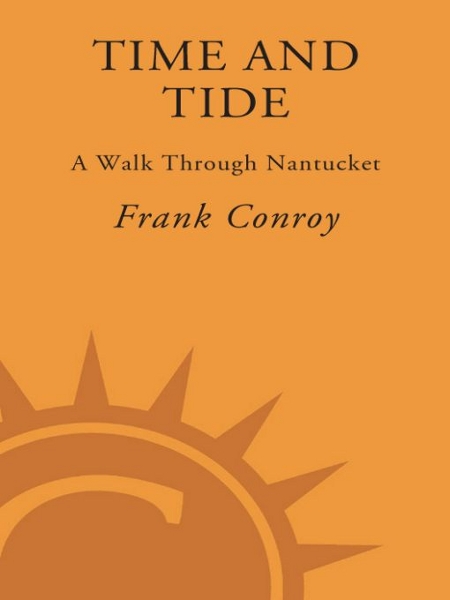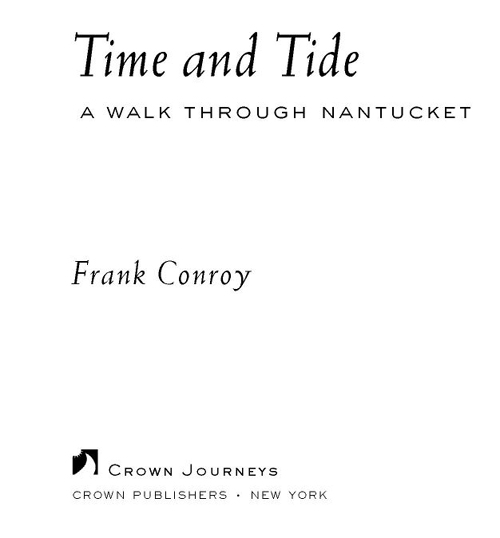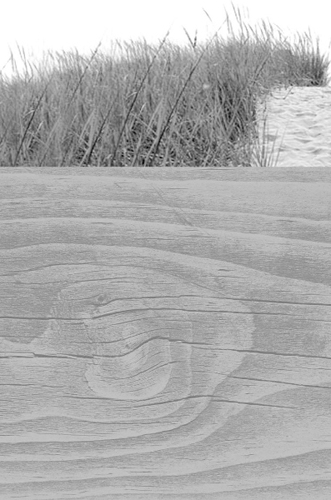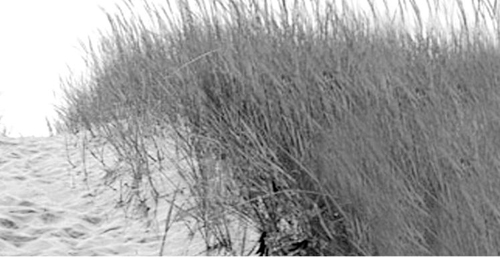Time & Tide



To Liam


PHOTOGRAPHS
The Barn going up.
36
Madaket Millie. (Courtesy of the Nantucket Historical Association F-6488) 39
Roadhouse band: Marty Ehrlich, Frank Conroy, Stan Strickland, Hugh Burrows, Akira Tana
(Credit:
Gene Mahon) 68
Third World Softball.
(Credit: Rick Blair) 78
Codfish Park. (Credit: Nicole Harnishfeger/ The Inquirer and Mirror) 96
Snow on Main St.
(Credit: Cary Hazelgrove) 110
Gracie and Maggie. (Credit: Frederick G.S. Clow/ The Inquirer and Mirror) 128
Frank and engine.
(Credit: Cary Hazelgrove) 130
PREFACE
I HAVE WRITTEN BEFORE ABOUT MY EARLIEST memory, but since it involves Nantucket, I'll do it again. I was perhaps three years old, being held by someone so I could look over the railing of the huge ferryboat on which we were passengers, to see the wharf, the water below, and the boys from town diving for coins thrown down by the people around us. Today, in my mind's eye I can still see the images, the moving images, although as if through a tube, images in a bright circle, all elseâthe larger setting, the boat, the town, the skyâlost.
A flashing coin is thrown, three or four boys dive, almost simultaneously, into the green water and disappear for a while. Almost simultaneously they emerge, one of them holding the coin aloft before slipping it in his cheek and looking up for the next nickel or dime. Young as I was I admired the boys, envying their energy and deft swimming. They seemed cheerful but also slightly tough, which interested me. The memory ends.
It was the Steamboat Wharf of Nantucket, I learned many years later and the occasion, a family excursion to an old hotel in Siasconset noted for its artsy clientele. (The building was torn down years ago and is forgotten now.)
I grew up with this isolated memory without knowing where it had occurred. I did not find out until I was in my thirties, when my mother mentioned it one night, apropos of nothing in particular, from what would turn out to be her deathbed in a New York City hospital.
Busy Days/Hot Nights
IN 1955, AT THE AGE OF NINETEEN, I ARRIVED on Nantucket for what I thought was the first time, accompanied by my college girlfriend and two other Haverford/Bryn Mawr couples. All six of us rented a three-room apartment over a bicycle shop (which still stands) for the summer. Those of us who needed them got jobs fairly quickly, because even in those days Nantucket in summer relied on imported labor. We'd come on a whim, the way kids used to do in the Eisenhower years, confident that we'd survive one way or another. My girlfriend got a job as the hostess of a small restaurant, I played the piano at the Whaler's Lounge in the basement of a ramshackle wooden hotel run by the Manchester family (where now stands the Jared Coffin House, a brick nineteenth-century building, still a hotel, pricey, with nothing ramshackle about it). One of the guys boned up on the small island's history from sources provided by a touring outfit and met the morning ferry every day to hawk the day-trippers into sightseeing rides in his little bus. A couple of the girls waited tables in a seafood joint. We survived, and had fun, walking the miles of empty beaches on our off time, swimming, having cookouts. We didn't use the apartment for anything but sleep, so jammed in were we those hot nights. Busy kids.
NANTUCKET IS AN island, roughly thirty miles out to sea, and its shape is important for several reasons. It has been described as a crescent moon by one writer, but to me it looks like some fantasized elf's slipperâ Madaket Harbor a worn-away toe, Surfside the sole, Siasconset the heel, Wauwinet the top of the heel, with a strip running up higher to Coskata, the long strip down Coatue, where the slipper's laces would tie, and then, even higher above Coskata, the final decorative tassel of Great Point.
The island itself is about fourteen miles long, and averages out at perhaps four miles wide, except for the long eastern shore, less than half of which is habitable. The sandy beach just north of Siasconset (or 'Sconset, as it is called by islanders) is the easternmost edge of the United States. The familiar Mercator Projection to be seen in every schoolroom makes it look like Maine sticks out farther, but that is no more than an effect of flattening three dimensions into two. On a globe Nantucket beats Maine by between two and three degrees.
As you look at a map of Nantucket, notice the small points of Coatue jutting into Nantucket Harbor. (They are named First Point, Second Point, Third Point, Five Fingered Point, Bass Point, and Wyers Point.) Nantucket Harbor is in fact a series of basins, spilling sequentially one into the other as the tide rises or falls. The circular movement of the water within the basins cutting and shaping the thin, grassy strip into the configurations revealed on the map.
The harbor is five miles long, and is of special interest to marine scientists and geographers because its basin arrangement, and the way the water moves in circles within it, are unique in the world. I have personally explored every part of the harbor with a series (over thirty-five years) of small boats, and bear witness to its beauty. The sudden, slightly exotic atmosphere of Coskata at the head of the harbor, inaccessible except by water, usually deserted, except in August, with its glades, hills, long ponds, and dunes, is especially alluring. Any one of the points, as you return, is worth exploring. You can swim in the shallows, fish for bass or bluefish in deeper waters, or simply cruise along in the sun.
Despite its great area one is never out of sight of land in the harbor, which is reassuring to the inexperienced sailor. If a fog bank rolls in and you can't see more than twenty feet in any direction, the thing to do is cut your engines, or lower your sail, and wait it out.
As seen from the Atlantic Ocean, Melville describes Nantucket thusly: “a mere hillock, and elbow of sand; all beach, without a background.”
And so it still appears from a distance, although not quite as bare as it was in the first half of the nineteenth century. A sense of the oceanâthe sound of it, or the smell of it, or a certain purity to the airâis felt everywhere on the island. Indeed, it's a pretty small patch of land, mostly moors because the severity of the winter winds preclude the growth of trees over much of its surface. There are a few “hidden forests” where the topography allows mostly scrub oaks. It resembles southern Scotland more than it does the neighboring island of Martha's Vineyard or the mainland. It is best explored on foot, off the roads, in September and October, when the moors change colors, veering toward purple, and the sunlight turns winey. Some find it too bleak, but many, like myself, do not.
BUSY KIDS, WORKING, making love, endlessly talking and arguing about the books and ideas we'd been exposed to the previous winter, we didn't have much time to explore. We seemed unable to get out of the lower Main Street area, with its side streets, post office, drug store, five & ten, etc.âthat fifth of the town that had been destroyed by the Great Fire of 1846 (which was the final blow to the island's foundering whaling industry) and rebuilt despite hard financial times. Once in a while we'd bike out to Surfside, or walk around the crumbling wharfs and slips of the town waterfront, but that was about it. Not even the boy driving the tour bus saw very much going out to 'Sconset and back, stopping every now and then for water views or a look at the cranberry bogs. What one saw from the roads represented only a hint of the uniqueness of the island in those days. Now, with so many houses, hedges, landscaping, fences, and general prettifying on the sides of the roads, the hint is a good deal weaker.
But much of the town of Nantucket looks a lot like it did fifty years ago. The lower part, where we roamed as kids, is similar to what the day-trippers see now, although the shops are more densely commercialized, and the prices are ridiculously high.
What we did not see then, and surprisingly few off islanders are aware of now, is that part of town that survived the fire: an entirely residential area on Upper Main Street and off Upper Main Street with a maze of lanes, narrow streets, alleys, and paths. To walk through old Nantucket town is to enter a living dream of the pastâa hundred and fifty, sixty, seventy years ago, sometimes two hundred years ago, these beautiful houses were built. Federalist, Greek Revival, and Quaker architecture predominate. In terms of the size of the streets, lanes, buildings, narrow sidewalks, and especially the harmonious proportions of it all, it is as it was. It is not a museum, people live here, but as quiet, calm, and peaceful as anyone could wish. One finds oneself walking softly, talking softly, without consciously deciding to do so. I have visited and seen many lovely towns across America, but nothing has taken my breath away like old Nantucket.
How did it come about? First, Nantucket was once a place in which the rich were truly, mind-bogglingly rich. I don't mean now, I mean in the first half of the nineteenth century, when whaling ships would go out to the Pacific Ocean for a couple of years and return to home port in Nantucket with a million dollars' worth of oil belowdecks for their owners. There was a working class in Nantucket, to be sure. Coopers, blacksmiths, carpenters, sailors, clam diggers, etc., who lived mostly on the low ground, near the water. Up a bit higher, on Orange Street, for instance, ship's captains built solid houses with widow's walks on the roofs from which one could see what was happening in the harbor (or put out a chimney fire). The filthy richâboat owners, investors, and businessmenâbuilt fine expensive homes on the high ground behind the Pacific National Bank at the top of Main Street. There was a certain amount of showing off on Upper Main, a kind of architectural one-upmanship in terms of size, style, and artistic discernmentâin perfect taste, of course. Nothing vulgar.
But then things changed. As Clay Lancaster explains in
Nantucket in the Nineteenth Century,
“The island's chief industryâwhale oilâhad been reduced to half by the introduction of camphine; it was cut another thirty percent by lard oil, and finally was given the death blow by the production of kerosene from petroleum and by piped gas.” The great whaling ships became passenger ships carrying prospectors (including a large part of the working class from Nantucket) out to California in the Gold Rush of '49 on a one-way trip for ships and passengers alike.
Well, there was still sheep herding. The animals had enjoyed more or less the run of the island for a long time, stripping vegetation efficiently (hence Melville's description), the cranberry industry was creeping along, as well as the extremely fragile beginnings of tourism, but the big money was gone. Hard times, even on Upper Main, where no one could do more than basic upkeep, and sometimes not even that, of the formerly grand houses. Many were boarded up. Even into the twentieth century they remained unimproved, untouched except for the most basic and superficial attentions. A ghostly neighborhood, sunk in the amber of a financial depression. Bad luck then, but good luck for us. Rich people came back eventually, more than a hundred years later, and they recognized the architectural gems as worth saving. They restored. They did not remodel, rebuild, modernize, tear down, or replace, as was going on in the rest of America. Over time they restored the whole neighborhood, and even extended it slightly with tasteful new structures in harmony with the old. The result constitutes an authentic treasureâan unforgettable architectural experience for even the most jaded.
ROBERT MOONEY, AN island attorney, in his interesting source book
Nantucket Only Yesterday,
begins his sixth chapter with the following: “The decade of the fifties marked a turning point from the long tradition of shared interests and close relationships within the Nantucket community. Prior to those years, the center of town was the place both residents and summer visitors mingled for shopping and recreational pursuits, typified by the evening sing-a-longs on Main Street after which everyone went home at ten o'clock.”
There is no doubt much truth in this view, and certainly one's impulse is to defer to Mr. Mooney, an extremely knowledgeable man about his hometown, but I think the larger turning point was in the seventies, and then again, even larger, in the nineties. Mooney believes, “The influx of tourists from the Hyannis boats . . . [and] the direct air service from Boston and New York brought a younger and livelier crowd . . .” And it doubtless did, but the really big changes were to come later.
In the fifties there were the town of Nantucket, the village of Siasconset, and the beach at Surfside. Everything happened in those three locations. The rest was moors, ponds, open space, and occasionally a house off Polpis Road, or a small cluster of houses near the water in a place like Quidnet, Polpis, or Wauwinet. (This last had a wonderful quiet old wooden hotel favored by the late John Cheever.) But the action, such as it was, was in lower Nantucket. The year-round population of the island had remained fairly steady for a hundred years at about 3,500. Mr. Mooney, who was in their number, describes their anti-Semitic, antigay feelings (which are still there for many year-rounders), suspiciousness of “flashy New Yorkers,” and some snobbism about day-trippers. I suppose a certain number of people felt that way, but my sense, arriving in 1955, was that most islanders were genuinely happy to see us. The winters were long, and it must have been stimulating to see some new faces, to feel the pace of life pick up a bit.
Summer people (as opposed to day-trippers) arrived on the large ferries like the
Uncatena
and the
Nobska,
which carried people, automobiles, and semis from Woods Hole on Cape Cod to Nantucket Harbor. As the boats rounded Brant Point through the narrow channel the battered old wharves and piers of the waterfront were suddenly revealed, and up higher, farther back, the church steeples, white and gold in the sun.
It was a town in those days, a real town in which everyone knew everyone else and behaved, perforce, in a civil manner, even toward the “summer people,” who outnumbered the year-rounders to be sure, but not so much that some of the civility didn't rub off on them. The small-town “feel” was one of the reasons myself and others kept returning summer after summer. It was a tonic indeed after New York City, where I lived after graduating from college. Nantucket was a small, relaxed oasis in the ocean.